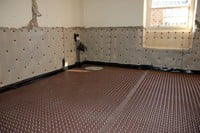Specialist Register Supports Industry
Structural waterproofing is an essential consideration for below ground works and construction professionals need to access an expert to assist with this element of the project. In this article, we give an insight into the types of structural waterproofing and explain the reasoning behind the Property Care Association’s new specialist register developed to signpost the industry to experts in this field.
A Background to Waterproofing Methods
As limits on space continue to put challenges on construction projects in the UK, many architects, designers and building professionals can be tasked with projects to create usable space below ground.
BS 8102:2009, the code of practice for protection of below ground structures against water from the ground, provides the basis for basement waterproofing design and covers three forms of construction that can be employed when creating dry rooms below ground, Type A, Type B and Type C.
Type A is often referred to as tanked protection. These are structures that have no integral protection against water penetration and rely totally on a waterproofing membrane to keep water out, and they can be created in masonry or in concrete. If a waterproofing membrane is included during the construction of the below ground space, it may be applied internally or to the outside of the structure or, in some cases, sandwiched between two skins of masonry or concrete. Multi-coat renders, cementitious coatings, epoxy resin systems and adhered bituminous sheeting are examples of Type A waterproofing.
Type A Waterproofing
Type A waterproofing is ideally suited to many types of waterproofing projects in both new build and renovation. Product selection, design and application are critical. Cracking, structural movement or mechanical damage following the application of the system will always compromise the integrity of a Type A system.

Type B Waterproofing
Structures built with a water resistant shell are referred to as Type B waterproofing systems. These will usually be constructed out of reinforced concrete to an appropriate design code, such as BS 8110 or BS 8007, which gives guidance in the grade of concrete to be used and spacing of the reinforcing steel. This type of waterproofing system is predominantly used in new build basements but can also be considered in some retrofit cellar applications. Should a Type B system fail then a type A or C system can usually be utilised to affect a remedy.
Type C Waterproofing
Type C or drained protection systems are now very common in basement renovations and conversions, but their use is growing in new buildings as well. Type C systems rely on a drained cavity within the basement structure. There is a permanent reliance on the cavity to collect groundwater that enters through the fabric of the structure. The drainage system directs the water to a drain or sump, where it can be removed from the building by gravity or pumping.
Type C systems have developed rapidly over the last two decades. Contractors now have access to some fantastic products, these include, high-density drainage membranes, advanced sealing and fixing systems, purpose designed perimeter drainage channels and state-of-the-art sump and pump packages. Most pumping systems now incorporate back-up pumps and batteries and an audible alarm. It is even possible to install a system that will call people on their mobile phone if it detects a fault.
A New Approach
Amends to BS 8102:2009, which replaced BS 8102:1990, now set out the requirement for an underlying Design Philosophy in conjunction with a risk assessed approach to below ground construction works.
Furthermore, the code of practice now recommends that a specialist in waterproofing is included in the design team for any structure where usable space is fully or partly below the ground level.
This is set out in section 4.2 of BS 8102:2009 under the heading Design Team. The code states:
A waterproofing specialist should be included as part of the design team so that an integrated waterproofing solution is created. The waterproofing specialist should:
- be suitably experienced;
- be capable of devising solutions that accommodate the various project constraints and needs;
- provide the design team with information and guidance that assists with and influences the design, installation and future maintenance of the waterproofed structure.
Regardless of the type of system, in the past an architect has often taken responsibility for waterproofing when designing below ground projects.
The choice of waterproofing methods appropriate to the individual conditions of the build is vitally important, but many would, however, acknowledge that they lack the training or expertise necessary to consider themselves as waterproofing specialists.
Reaching the Experts
Until now there has been no register or central point where those with the relevant skills can identify themselves. In the past the only way to recognise an individual who has successfully achieved the Certificated Surveyor in Structural Waterproofing (CSSW) qualification was to ask individual companies if they employ such a person.
Now, with the publication of the register of Waterproofing Design Specialists, developers, architects and builders can quickly locate individual practitioners who can assist in the design and planning of underground waterproofing. This ability will allow them to conform to the recommendation set out clearly in BS 8102.
The code says that waterproofing specialist should be suitably experienced, be capable of devising solutions that accommodate the various project constraints and needs, and provide the design team with information and guidance that assists with and influences the design, installation and future maintenance of the waterproofed structure.

Ultimately, the availability of the register will ensure that a properly vetted and approved Waterproofing Design Specialist, is available and accessible to the leader of any design team.
In accordance with BS8102:2009, a Waterproofing Design Specialist accredited by the PCA will have knowledge of the following:
The waterproofing systems available.
An in-depth understanding of the requirements of BS 8102.
Sources of water, and how it flows through the soil and interacts with the structure.
Sufficient structural knowledge to be able to discourse meaningfully with the structural engineer.
Sufficient geotechnical knowledge to be able to understand the implications of a soil report, and to discourse meaningfully with the geotechnical engineer.
A standard skillset is also required to be on the PCA’s Waterproofing Design Specialist register, and in order to be accepted an individual must;
Demonstrate competence in all aspects of structural waterproofing
Be a member or be employed by a member of the Property Care Association
Have attained the Certificated Surveyor in Structural Waterproofing (CSSW) qualification
Have an on-going commitment to skills development and participate in the PCA’s
Continuing Professional Development (CPD) scheme
Hold Professional Indemnity Insurance
Furthermore, those featured on the Register must observe the Association’s Code of Ethics and all the relevant standards that relate to the conduct and behaviour of members.
Once the design is agreed, a member of the PCA’s structural waterproofing group can be called upon to carry out the necessary works.
Remember to keep in the loop…
Find out the latest news instantly by following the PCA via our social media channels:
Follow us on LinkedIn Follow us on Facebook Follow us on twitter